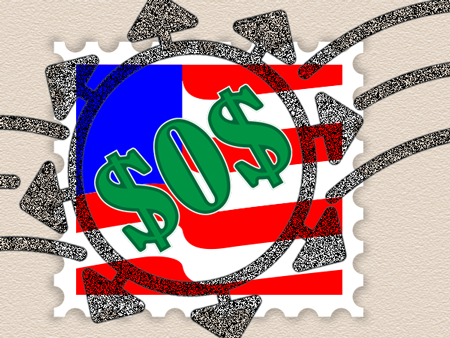In an effort to close the gap between revenue and operating costs, a Postal Service rate increase request has been submitted to the Postal Regulatory Commission affecting certain rates effective January 24, 2021. The impacts of the COVID-19 pandemic, plus continued declines in the volume of Market Dominant products like First Class Mail have continued a revenue decline that has persisted over more than a decade. While the Postal Regulatory Commission has oversight responsibility for the USPS. Congress exercises its “power of the purse” when it comes to granting price increases.
Proposed increases for 2021 are 1.9% for First Class Mail and 1.5% for other categories including Marketing Mail®. In 2019 $16.4 billion in Marketing Mail® was handled by the USPS (part of the $1.6 trillion U.S. mailing industry). However in the USPS third quarter report for 2020, Marketing Mail® revenue declined by $1.4 billion, or 37.2 percent, on a volume decline of 6.4 billion pieces, or 36.4 percent.
Impacts due to the pandemic included higher transportation costs, compensation costs that accompany increased package volume, PPE, plus retirement and health benefits to name a few. This was partly offset by increases in package and shipping volume and revenue, which increased by $2.9 billion YOY, or 53.6%. The result however, was a $2.2 billion net loss for Q3 2020.
How Does Postage Affect A Direct Mail Budget?
A budget for producing and sending a marketing mail piece must also include design and printing, but list data and postage costs tend to constitute the lion’s share of a direct mail campaign. The USPS has a handy budget calculator tool that estimates the cost of postage for sending 40,000 letters with envelopes using current Marketing Mail® rate of $.29 each would be $11,600.
So in the midst of a pandemic-induced recession, how should direct marketers respond? Everyone knows direct marketers depend on accurate and affordable audience data to identify prospects they want to reach. Absent that, a campaign is dead in its tracks. Then, they rely on the United States Postal Service to complete the connection by delivering marketing mail reliably and economically.
Data And Discipline Save The Day (And Budget)
In a challenging economic climate, planning campaigns at scale will depend more than ever on trimming fat and sharpening focus. Overly broad, undisciplined targeting can be wasteful. Hitting it big on a spray and pray mailing is a tempting goal, but risks squandering reputational capital on unwelcome contact.
Incomplete or incorrect records can hinder the deliverability of a campaign’s primary mailpiece. Money is wasted on design, printing, and postage. The opportunity for follow up via phone or email is also lost. Data append services can remedy this shortfall of valuable contact information, increasing potential campaign revenue.
Build a list that resembles your customer base. Consult an experienced data professional to guide you through the process. An effective look-alike list will use SIC/NAICS codes to identify and evaluate businesses in any industry sector. Must-have demographic and firmographic data elements include top contact, phone number, HQ/branch address, employee size, revenue, sales forecast, years in business, geography, and ownership profile (e.g. women, minority, veteran). Expand the reach and heighten the efficiency of your campaign to ensure a degree of relevance that yields results.
You Have To Save Money To Make Money…Really?
Despite a looming postal service rate increase, the USPS offers many ways mailers can save money on campaigns and get more from their budgets, improving response to offers and promotions.
If a mailer really needs broad coverage, Every Door Direct Mail® can accomplish this goal for as little as $0.164 per piece. When geography PLUS coverage matters, campaigns can be focused on specific zip codes and postal routes, plus Census data based parameters such as age or income. All while achieving the broad reach required.
Direct marketers can increase the power of their mailpiece by employing advanced technologies the USPS supports, enabling recipients to launch digital experiences and take immediate action through QR codes and more. All it takes is printing the link to digital content or a transactional landing page. The USPS provides a directory of technology integrators to assist mailers with implementing these options.
How Do Postal Rates Compare Around The World?
The USPS charges $0.55 to send a first class letter anywhere in the U.S., from Maine to Hawaii. Want to send a letter in Rekjavik? That’ll be $5.82 (converted from Euros). Copenhagen? $4.27. A Deutsche Post (p7) letter price survey that includes the major industrial nations of Europe found that at $0.55, the USPS was cheaper than all of them. For global perspective, even Australia Post gets $0.709 for a standard letter. With such a large service area and spread out population, the USPS faces a challenging task to maintain its high standards.
Any postal service rate increase is linked to the Consumer Price Index (CPI) by the Postal Accountability and Enhancement Act. There has been sentiment directed at rolling back this measure enacted during a lame duck session of Congress, but raising the price of something practically every American uses is a bit of a political football.
So is the requested rate increase justified? That will be for Congress to decide. With prices tethered to inflation it is no wonder that in an age of texting and email the USPS has difficulty staying even. After all, it is not funded by tax dollars but rather via the revenue generated by products and services.
Staying True To The Creed
It should also be noted that the USPS collaborates with parcel delivery services like FedEx and UPS to the benefit of all Americans who increasingly rely on package delivery during the pandemic. The USPS puts its 228,000 vehicles to work delivering letters and packages anywhere in the U.S. for the same price, while gaining use of competitors’ air cargo fleets, and the Postal Service does not add surcharges for fuel, residential delivery or regular Saturday delivery. The USPS placed at #1 in The Harris Poll Essential 100, a ranking of corporate response to the COVID-19 pandemic. So perhaps “global pandemic” should be added to the litany of obstacles the USPS pledges to accomplish the completion of its appointed rounds.




